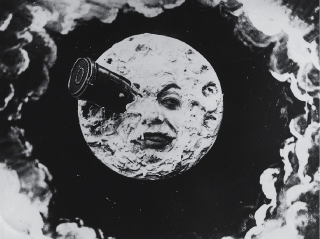Movies and Film: A Century of Cinematic Splendor
A Century of Cinematic Splendor
MGM was only a glint in Louis B. Mayer's eye when Lon Gaumont, a photographic merchandiser, began producing and marketing films at the turn of the century. Gaumont soon became one of the nation's leading studios. Charles Path created an even more massive corporation; by 1910, Path was marketing many more movies in America than all U.S. companies combined.
This French dominance of the international film industry had many practical effects, not the least of which was the huge influence of French filmmaking on American directors. Succeeding generations of Gallic geniuses would continue to exert unparalleled creative and artistic pressures upon world cinema.
The Movies' First Magician
Nearly a century before there was Industrial Light and Magic, there was Georges Mlis.

Georges Mlis's illusionist moon from Le Voyage dans la Lune (A Trip to the Moon, 1902).
Second Take
It's one of the greatest losses in the history of film. In 1923, penniless and virtually forgotten, Georges Mlis sold the negatives of practically all his films to a factory for the market price of the celluloid. Only a few dozen films survive out of the thousands he made.
Among the enthralled attendees at the Lumire brothers' Grande Caf showing on that fateful night in 1895 was a 34-year-old son of a rich shoemaker. A magician and illusionist by trade, Georges Mlis was taken by the new medium and vowed to transfer his considerable talents from the variety stage to celluloid.
With the family money he had inherited, Mlis constructed what would become the world's first real film studio in a huge structure in Montreuil-sous-Bois. His command over every aspect of his filmmaking was legendary, as he produced, directed, edited, and acted in practically every film he shot. During the next 20 years, he cranked out perhaps thousands of short films featuring some of the world's first trick photography—for example, scenes in which a figure would be standing on a street corner and magically disappear in the space of a single frame.
Mlis's best-known and most beloved film remains Le Voyage dans la Lune (A Trip to the Moon, 1902), a charming and still quite enjoyable short that established his international reputation practically overnight. Though his star gradually faded as he ran out of cash and other filmmakers ascended into the public eye, he was "rediscovered" in the late 1920s and given a free place to live out his years.
Many film historians and theorists still credit the stylistic differences between the films of the Lumire brothers and those of Georges Mlis with giving rise to the split between the documentary film and the fiction film. This is probably something of an exaggeration, but it's undeniable that Mlis's tricky innovations inspired countless attempts at cinematic illusion-making during the past century.
Director's Cut
One day, at the height of his career, Charlie Chaplin autographed a photo of himself for the French film comedian Max Linder. In the inscription, Chaplin identified Linder as "The Professor—to whom I owe everything." High praise indeed from the world's biggest movie star!
But Chaplin was serious about his debts to Linder, whose film career in the 1900s and 1910s soared to unprecedented heights and established him as the leading man of French film comedy. Playing the character of Max in dozens of silents with titles like Max prend un bain (1910), Max victime de quinquina (1911), Max professeur de tango (1912), Max torador (1912), and later, in the United States, Max in a Taxi (1917), Linder created a debonair, sophisticated bungler whose deft antics provided a cool Parisian reply to America's Keystone Kops.
The personal and professional relationship between Linder and Chaplin wasn't all harmony and laughs, however. When Chaplin's films started pulling in the big bucks internationally, Linder faded into relative obscurity, an experience that left him embittered enough to take his own life.
Excerpted from The Complete Idiot's Guide to Movies and Film © 2001 by Mark Winokur and Bruce Holsinger. All rights reserved including the right of reproduction in whole or in part in any form. Used by arrangement with Alpha Books, a member of Penguin Group (USA) Inc.
To order the e-book book direct from the publisher, visit the Penguin USA website. You can also purchase this book at Amazon.com.







